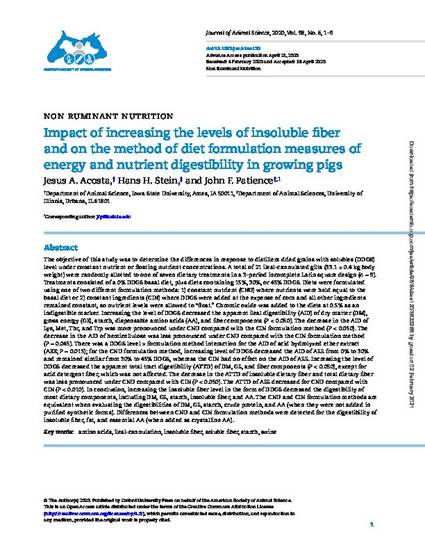
The objective of this study was to determine the differences in response to distillers dried grains with solubles (DDGS) level under constant nutrient or floating nutrient concentrations. A total of 21 ileal-cannulated gilts (33.1 ± 0.4 kg body weight) were randomly allotted to one of seven dietary treatments in a 3-period incomplete Latin square design (n = 9). Treatments consisted of a 0% DDGS basal diet, plus diets containing 15%, 30%, or 45% DDGS. Diets were formulated using one of two different formulation methods: 1) constant nutrient (CNU) where nutrients were held equal to the basal diet or 2) constant ingredients (CIN) where DDGS were added at the expense of corn and all other ingredients remained constant, so nutrient levels were allowed to “float.” Chromic oxide was added to the diets at 0.5% as an indigestible marker. Increasing the level of DDGS decreased the apparent ileal digestibility (AID) of dry matter (DM), gross energy (GE), starch, dispensable amino acids (AA), and fiber components (P < 0.050). The decrease in the AID of Lys, Met, Thr, and Trp was more pronounced under CNU compared with the CIN formulation method (P < 0.050). The decrease in the AID of hemicellulose was less pronounced under CNU compared with the CIN formulation method (P = 0.045). There was a DDGS level × formulation method interaction for the AID of acid hydrolyzed ether extract (AEE; P = 0.015); for the CNU formulation method, increasing level of DDGS decreased the AID of AEE from 0% to 30% and remained similar from 30% to 45% DDGS, whereas the CIN had no effect on the AID of AEE. Increasing the level of DDGS decreased the apparent total tract digestibility (ATTD) of DM, GE, and fiber components (P < 0.050), except for acid detergent fiber, which was not affected. The decrease in the ATTD of insoluble dietary fiber and total dietary fiber was less pronounced under CNU compared with CIN (P < 0.050). The ATTD of AEE decreased for CNU compared with CIN (P < 0.010). In conclusion, increasing the insoluble fiber level in the form of DDGS decreased the digestibility of most dietary components, including DM, GE, starch, insoluble fiber, and AA. The CNU and CIN formulation methods are equivalent when evaluating the digestibilities of DM, GE, starch, crude protein, and AA (when they were not added in purified synthetic forms). Differences between CNU and CIN formulation methods were detected for the digestibility of insoluble fiber, fat, and essential AA (when added as crystalline AA).
Available at: http://works.bepress.com/john-patience/95/

This article is published as Acosta, Jesus A., Hans H. Stein, and John F. Patience. "Impact of increasing the levels of insoluble fiber and on the method of diet formulation measures of energy and nutrient digestibility in growing pigs." Journal of animal science 98, no. 6 (2020): skaa130. doi: 10.1093/jas/skaa130.